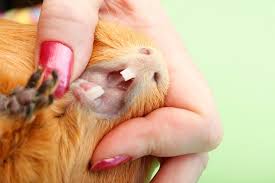Pets
Is cancer painful for dogs? – 9 Tips to Know When Your Pet Has Cancer

9 Tips to consider When Your Pet Has Cancer
A cancer diagnosis of a loved one is challenging on multiple levels. It is common to feel helpless when your companion pet or animal is diagnosed with cancer.
You may educate yourself and care for your animal with cancer by taking certain actions. When you hear the words “your pet has cancer,” the ten actions below will reduce your anxiety and help you understand what to do.
Is cancer painful for dogs?
Cancer is a horrible disease that can make your cherished friend wretched.
If you suspect that your dog is in discomfort, get veterinarian attention immediately.
Even if their discomfort is not caused by cancer, we can provide remedies to keep them comfortable.
1. Recognize the prevalence of cancer in pets
The development of cancer in your pet is not unusual. As with people, as your pet ages, their immune system weakens and their cancer risk increases.
Neither you nor your cat are alone during these trying times. Cancer is the leading cause of death for 47% of dogs (particularly dogs over the age of 10) and 32% of cats, according to the Veterinary Cancer Society.
Dogs contract cancer at roughly the same rate as humans, although cats are less susceptible. There are about 100 different forms of canine cancer.
Mast cell tumors are the most prevalent among canines.
Leukemia and lymphoma are the most frequent malignancies in cats.
Cancer is typically prevalent in older animals, but certain breeds have greater rates than others.
Joining and attending a support group for pet owners dealing with sick animals may be beneficial. This can help mitigate your dread, solitude, and anxiety.
Check with your veterinarian for information on local, in-person groups in addition to the online groups provided below.
Please note that these online communities are often moderated by other pet owners and not necessarily mental health professionals.
Consider connecting with a competent therapist if you feel the need for increased psychological help.
Your veterinarian should be able to connect you with local resources for grieving support.
2. Understand Your Pet’s Cancer
Cancer has been diagnosed in your pet. Cancer is a disease caused by the uncontrolled multiplication of cells in the body.
Cancers are frequently referred to by the sort of cell whose growth is out of control. The phrases cancer, malignancy, and neoplasia are interchangeable; they all refer to cancer in different ways.
There are numerous forms of cancer, and their behaviors vary. Some types of cancer can spread to distant areas within the body. This occurs as a result of the cancer cells’ ability to penetrate the blood and lymph arteries and spread to other organs.
It is called metastasis when cancer has spread to other parts of the body.
As with any diagnosis, whether in a pet or a person, you should educate yourself on your pet’s treatment options, expenses, and pros and disadvantages.
3. Know Your Pet’s Treatment Alternatives
There are numerous cancer treatments available for companion animals.
Surgical procedures, chemotherapy, radiation therapy, and immunotherapy are included.
Some malignancies will be treated with a single therapy, while others may require combination therapy (2 or more different therapies).
Your pet may be requested to participate in a clinical trial in an effort to investigate newer (and presumably more effective) forms of therapy.
The objective of these studies is to learn more about the precise sort of treatment (which may be beneficial to humans and other animals with cancer) while also hopefully benefiting your pet.
4. Consult with a veterinary oncologist
When your pet is diagnosed with cancer, you may be unsure of the available treatment options.
Obtain a second opinion from a board-certified veterinary oncologist, like we do in human health. This may validate a chosen course of treatment for your pet or bring up new possibilities.
The Veterinary Cancer Society’s website provides pet owners with useful tools, such as “Find an expert in your area.” www.vetcancersociety.org
On its website, the American College of Veterinary Internal Medicine includes a section for pet owners. www.acvim.org.
5. Acquire Knowledge of Terminology
The veterinary oncologist will explain what is occurring within your pet’s body. Understanding veterinary medical terminologies will help you comprehend the oncologist’s recommendations for your pet.
Before your visit, do some reading to familiarize yourself with some of the phrases used.
Bring a notebook to your oncology appointment with your pet so that you can take notes on treatment options and next actions. Do not fear asking questions.
6. Understand how veterinarians perform tumor testing
In order to identify the degree of the malignancy, your veterinarian may perform many diagnostic tests.
These may include blood tests (such as blood count and chemical profile), urinalysis, radiographs (X-rays and ultrasound), tissue aspiration, and biopsy.
Due to the fluctuating nature of your pet’s condition, tests performed by your local veterinarian may be redone at a cancer specialty clinic.
Ultrasound, specialized radiologic studies (e.g. nuclear scan, CT or MRI scan, dye contrast studies), bone marrow aspirate, lymph node aspirate, endoscopy (direct examination of the stomach, colon, or lung with a specialized scope and camera), and immunologic studies are additional tests that may be used.
After completing these tests, your veterinarian will be in a better position to discuss treatment choices for your pet. Additionally, the purpose of therapy will be discussed.
In most cases, metastasized (spread to other locations) tumors are incurable.
Therefore, palliation is the aim of therapy for these animals (relieve of symptoms and possibly prolong life, without providing a cure).
Localized cancers that do not infiltrate neighboring tissues have the highest likelihood of being treated.
7. Consider Your Pet’s Quality of Life
The goal of cancer treatment for animals is to alleviate pain and suffering while preserving the quality of life for as long as possible. Typically, treatment is significantly less aggressive than in humans.
What delights your pet? Is it swimming at the local pond, sunbathing on the front porch, hiking through the woods, or simply cuddling with you?
If your pet cannot enjoy these activities, or if they give them further distress, their quality of life is diminished.
Occasionally, your veterinarian can provide symptom management to ease pain and suffering, and occasionally, when the quality of life is compromised, we must consider euthanasia.
8. Know the Financial Consequences of Your Pet’s Cancer
Veterinary treatment for pets can be expensive. If you have pet insurance, the time has come to utilize it! If not, CareCredit is an option for financing veterinary treatment; however, the veterinarian must be a certified provider with CareCredit.
Inquire if your veterinarian’s office accepts CareCredit.
CareCredit can help you pay for your pet’s out-of-pocket medical bills with set interest rates and greater repayment flexibility than typical credit cards. But be cautious to read the fine print and consider the potential long-term debt you may acquire.
You might also consider crowdsourcing/fundraising using services such as GoFundMe.
Lastly, if you cannot afford the vet fee, several pet support organizations may be of great assistance.
The Best Friends Animal Society provides a handy list of organizations and funding possibilities.
9. Maintain a regular regimen
Fun activities such as exercise, walks, and playtime will help you and your pet keep a healthy mentality. Our pets like routine. It helps them remain active and interested, especially if they’ll be making frequent trips to the veterinarian for treatment.
Finally
Be optimistic and hopefully at all times..
Our dogs require both our care and ours. Although some animals may endure brief discomfort from therapy, the majority of pets with cancer may be treated without causing significant distress or diminishing their quality of life.
Even if an animal has been diagnosed with cancer, it is not necessarily the end of its existence.
Together, your dedication to your pet and your physicians’ commitment to provide cutting-edge treatment will ensure that your pet is as content as possible.
Questions people are asking
Can most dogs beat cancer?
Cancer is the biggest cause of mortality in pets older than middle age, affecting one in four dogs throughout the course of their lifetimes. As with humans, certain types of canine cancer are more prevalent than others.
Fortunately, many dogs diagnosed with cancer can continue to enjoy quality lives with the help of treatment.
What proportion of canines survive cancer?
Large dogs may have a longer survival span, and the cure rate is 20%.
If a tumor is completely removed, the animal will typically receive low doses of radiation to prevent recurrence. The survival rates are 59% at 1 year, 40% at 3 years, and 13% at 5 years.
Where does canine cancer typically begin?
Lymphoma, a cancer of the lymph nodes and lymphatic system, is one of the most often diagnosed tumors in dogs.
Lymphoma can affect numerous organs in dogs, but it is most frequently detected in the peripheral lymph nodes, which are located deep beneath the subcutaneous tissue (the innermost layer of the skin).
Do cancerous dogs smell?
An Unusual scents
Bad breath in dogs is common, but if it is significantly worse than usual, it may indicate a tumor. Tumors can also cause a dog’s nose or tail to emit bad scents.
Which cancer kills canines?
Hemangiosarcoma is particularly dangerous because the expanding tumors can rupture, resulting in large and often fatal blood loss.
Despite the fact that some dogs exhibit no clinical symptoms prior to tumor rupture, others demonstrate lethargy and weakness.
Should a dog diagnosed with cancer be euthanized?
Cancer Might Not Be an Imminent Cause of Death
If your dog does not appear to feel or behave sick, it is likely not time yet.
You may need to take it day-to-day. At some point, though, you may begin to see indicators that it is time to proceed with euthanasia.
What is the dog cancer with the fastest growth rate?
Hemangiosarcoma. Hemangiosarcoma is a highly malignant cancer that can rapidly spread and form tumors virtually everywhere in the body.
It is most commonly detected in the heart and spleen of dogs. Frequently, it is in an advanced stage when it is diagnosed.
How can I naturally combat my dog’s cancer?
In addition, hempseed oil has been demonstrated to inhibit brain, breast, and lung cancer spread and growth.
Additionally, hemp seed is rich in essential nutrients such as manganese and zinc, making it a nutritious supplement to any diet. To offer your dog hemp seed, you can either purchase it as an oil or crush it fresh.
Does canine cancer spread rapidly?
Large dog breeds, such as poodles, are most susceptible to bone tumors as they mature from puppyhood. This type of cancer can be extremely aggressive, rapidly spreading throughout the body.
What do dogs with cancer prefer to eat?
High-quality proteins, such as those found in dairy products derived from goats or sheep, eggs, low-mercury seafood, organ and muscle meat, preferably naturally grown, are recommended for dogs with cancer.
Carbohydrates with a low glycemic index (GI), such as sweet potato, broccoli, quinoa, and gluten-free oats.
Can dogs sense when they are dying?
Some dogs will recognize that the end is near and will seek comfort from their owners.
To say goodbye to your dog with love and dignity, you must be present during his or her final hours and reassure him or her with gentle petting and a soothing voice. Take a break from work or whatever else is occurring.
Do canines with cancer consume more water?
Cancers of the adrenal gland, pituitary gland, and thyroid gland, as well as cancers of the liver and kidneys, can increase thirst in dogs and cats, resulting in an increased desire to urinate.
Conclusion:
We hope you enjoyed this article… What are your thoughts?
Please feel free to share with us in the comments section below….
Pets
The Healing Power of Pet Memorials: How They Help Us Cope

Losing a pet is one of the most heartbreaking experiences anyone can endure. Pets are not just animals; they are cherished family members who provide unconditional love, companionship, and joy. When a pet passes away, the grief can be overwhelming, leaving a deep void in our hearts.
However, many people find comfort in pet memorials, which offer a tangible way to honor and remember their beloved companions. Pet memorials and pet memorial gifts play a crucial role in the healing process, helping individuals cope with their loss in meaningful ways.
The Emotional Benefits of Pet Memorials
Grief is a natural response to loss, and everyone experiences it differently. Some people may find solace in sharing memories with friends and family, while others might prefer solitude and reflection. Regardless of the grieving style, pet memorials can provide emotional benefits that help ease the pain of loss.
1. Creating a Lasting Tribute:
Pet memorials allow pet owners to create a lasting tribute to their departed pets. Whether it’s a simple photo frame with a favorite picture, a custom-engraved stone, or a more elaborate memorial garden, these tributes serve as a permanent reminder of the love and bond shared. By having a designated space or item dedicated to the memory of a pet, owners can revisit those cherished moments and feel a sense of connection even after their pet is gone.
2. Acknowledging the Loss:
One of the significant aspects of the grieving process is the need to acknowledge the loss. Pet memorials help validate the grief that comes with losing a pet. In a society that sometimes downplays the significance of pet loss, having a pet memorial or receiving pet memorial gifts can affirm that the grief is real and worthy of attention. It gives individuals the opportunity to openly mourn and honor the importance of their pet’s life.
3. Finding Comfort in Rituals:
Rituals play a crucial role in the grieving process. They provide a structure for expressing emotions and saying goodbye. Pet memorials often involve rituals, such as lighting a candle, planting a tree, or holding a small ceremony in memory of the pet. These rituals can offer comfort and closure, allowing pet owners to process their emotions in a controlled and purposeful manner.
4. Preserving Memories:
Over time, memories of a beloved pet may fade, but pet memorials help keep those memories alive. By creating a physical reminder, such as a memorial plaque, a piece of jewelry containing the pet’s ashes, or a custom portrait, owners can ensure that their pet’s memory remains vivid and cherished. These memorials serve as a source of comfort, reminding owners of the happy times and the love they shared with their pet.
How Pet Memorial Gifts Aid in Healing
In addition to personal memorials, pet memorial gifts can also play a significant role in the healing process. When friends and family offer pet memorial gifts, they provide not only a token of remembrance but also a gesture of support and understanding.
1. Offering Support:
Receiving pet memorial gifts from loved ones can be a comforting experience. It shows that others recognize the depth of the loss and are there to offer support. These gifts, whether they are sympathy cards, personalized keepsakes, or memorial jewelry, can provide solace during a difficult time. They serve as a reminder that the pet was loved and that the grief is shared by others who care.
2. Encouraging Expression:
Grief can sometimes be an isolating experience, particularly when others may not fully understand the bond between a person and their pet. Pet memorial gifts encourage the expression of emotions, allowing grieving pet owners to share their feelings and memories. This can be an essential step in the healing process, as it helps individuals process their grief rather than keeping it bottled up inside.
3. Creating New Traditions:
Pet memorial gifts can also inspire the creation of new traditions that honor the memory of the pet. For example, a personalized ornament or a custom photo book can become a cherished part of holiday celebrations, ensuring that the pet’s memory is kept alive year after year. These traditions can bring comfort and a sense of continuity, helping individuals cope with the loss while still feeling connected to their pet.
4. Promoting Healing Through Art:
Many pet memorial gifts involve artistic expression, such as custom portraits, engraved stones, or hand-crafted urns. Engaging with art can be a therapeutic way to process grief. The beauty and creativity of these gifts can bring peace to a grieving heart, offering a tangible representation of the love and bond shared with the pet.
Conclusion
The loss of a pet is a deeply emotional experience, but pet memorials and pet memorial gifts can provide a pathway to healing. They offer a way to honor and remember the special bond shared with a beloved pet, helping to ease the pain of loss. By creating lasting tributes, acknowledging the grief, and encouraging the expression of emotions, these memorials play a vital role in the grieving process.
Whether through personal rituals or the support of loved ones, pet memorials help us cope with the loss of our furry friends and keep their memories alive in our hearts forever.
Pets
Can Pets Carry Bed Bugs? Facts You Need to Know

Bed bugs are a growing concern for many homeowners and renters, and it’s natural to wonder if our beloved pets can also be affected by these pesky insects.
As a leading pet blogger and writer, I’m here to provide you with a comprehensive guide on whether pets can carry bed bugs and what you can do to protect your furry friends.
Can Pets Carry Bed Bugs?
The short answer is yes, pets can carry bed bugs. While bed bugs primarily feed on human blood, they are not exclusive to humans and can also feed on the blood of animals, including pets. Pets such as dogs, cats, rabbits, and even birds can become infested with bed bugs.
Bedbugs are the only animal that can send a landlord or house owner out of their own house. I once read that if there’s a nüclear êxplosiœn only two animal will survive
You got it right – Bedbugs and Cockroaches , they’ll survive any level of nüclêar… pic.twitter.com/SRetCw0dhy
— NaijaFarmer (@Nig_Farmer) March 23, 2024
Bed bugs are adept at hiding and can easily hitch a ride on your pet’s fur or in their bedding. Once they’ve made their way into your home, they can quickly spread to other areas, including your own sleeping quarters.
How Do Pets Get Bed Bugs?
Pets can pick up bed bugs in a variety of ways. The most common ways include:
- Visiting Infested Locations: If your pet accompanies you to a location that is infested with bed bugs, such as a hotel, motel, or even a friend’s home, they can pick up the bugs and bring them back to your own home.
- Contact with Infested Animals: If your pet comes into contact with another animal that is infested with bed bugs, they can also become a carrier.
- Secondhand Furniture or Bedding: Bed bugs can hide in used furniture, mattresses, or bedding, and if your pet comes into contact with these items, they can pick up the bugs.
- Traveling: If you take your pet with you on trips, they can pick up bed bugs in hotels, motels, or other accommodations that may be infested.
Signs of Bed Bug Infestation in Pets
Identifying a bed bug infestation in pets can be challenging, as the signs are often subtle. However, some common signs to look out for include:
- Visible Bed Bugs: You may spot the actual bugs crawling on your pet’s fur or in their bedding.
- Bites: Bed bug bites can cause itchy, red welts on your pet’s skin, similar to those seen on humans.
- Fecal Stains: Bed bugs leave behind small, dark fecal stains on surfaces where they hide.
- Molted Skins: As bed bugs grow, they shed their exoskeletons, which can be found in your pet’s bedding or sleeping areas.
If you suspect your pet may have a bed bug infestation, it’s important to contact a professional pest control expert for an inspection and proper treatment.
Protecting Your Pets from Bed Bugs
To protect your pets from bed bugs, it’s important to take proactive measures. Here are some tips:
- Regularly Inspect Your Pet’s Bedding and Sleeping Areas: Carefully examine your pet’s bedding, crate, and other sleeping areas for signs of bed bugs, such as the bugs themselves, fecal stains, or molted skins.
- Vacuum Regularly: Regularly vacuuming your pet’s sleeping areas, as well as the rest of your home, can help remove any bed bugs or their eggs.
- Use Bed Bug-Resistant Bedding: Consider using bed bug-resistant bedding or covers for your pet’s sleeping areas to make it more difficult for the bugs to hide and thrive.
- Treat Infestations Promptly: If you do find evidence of a bed bug infestation, it’s important to act quickly. Contact a professional pest control expert to properly treat the issue and prevent it from spreading.
- Limit Your Pet’s Exposure to Infested Areas: If you’re aware of a bed bug infestation in a location your pet may visit, such as a friend’s home or a hotel, try to limit your pet’s exposure to that area.
By following these steps, you can help protect your pets and your home from the unwanted presence of bed bugs.
Frequently Asked Questions
1. Can bed bugs live on pets?
Yes, bed bugs can live on pets, although they prefer to feed on human blood. Pets such as dogs, cats, rabbits, and even birds can become infested with bed bugs.
2. How do I know if my pet has bed bugs?
Signs of bed bug infestation in pets include visible bugs, bites, fecal stains, and molted skins. If you suspect your pet has bed bugs, it’s important to contact a professional pest control expert for an inspection and proper treatment.
3. Can bed bugs spread from pets to humans?
Yes, bed bugs can spread from pets to humans. If your pet has a bed bug infestation, the bugs can easily transfer to your own sleeping areas and start feeding on you as well.
4. How do I treat bed bugs on my pet?
Treating bed bugs on pets should be done in conjunction with treating the overall infestation in your home. Your veterinarian may recommend using pet-safe insecticides or other treatments to eliminate the bed bugs on your pet.
5. Can I prevent my pet from getting bed bugs?
Yes, there are steps you can take to prevent your pet from getting bed bugs, such as regularly inspecting their bedding, using bed bug-resistant bedding, and limiting their exposure to infested areas.
References:
- “Bed Bugs and Pets.” Centers for Disease Control and Prevention, www.cdc.gov/parasites/bedbugs/faqs.html.
- “Can Pets Get Bed Bugs?” Terminix, www.terminix.com/blog/education/can-pets-get-bed-bugs/.
- “Bed Bugs and Pets: What You Need to Know.” PetMD, www.petmd.com/dog/parasites/bed-bugs-and-pets-what-you-need-know.
Animals
Guinea Pig Teeth: All You Need to Know About Guinea Pig Dental Care

Guinea Pig Teeth: All You Need to Know About Guinea Pig Dental Care
Guinea pigs are adorable and gentle pets, but their dental health often goes overlooked. Just like humans, these furry friends require proper dental care to ensure they lead happy and healthy lives. In this comprehensive guide.
we’ll delve into everything you need to know about guinea pig dental care, from understanding their unique dental anatomy to providing essential dental maintenance tips.
Guinea pigs have unique dental needs that necessitate special care and attention from their owners.
Their teeth grow continuously throughout their lives, requiring proper maintenance to prevent overgrowth, misalignment, or other dental problems.
Unlike humans, guinea pigs’ teeth lack roots and are open-rooted, meaning they grow continuously to compensate for wear from chewing.
To maintain your guinea pig’s dental health, provide a balanced diet rich in hay, fresh vegetables, and high-quality pellets. These foods help wear down their teeth naturally and provide essential nutrients for dental health.
Additionally, regular veterinary check-ups are essential to monitor your guinea pig’s dental condition and address any emerging issues promptly.
By prioritizing proper dental care, you can ensure your guinea pig enjoys a happy, healthy life free from the discomfort and complications associated with dental problems. Remember, a little attention to dental care goes a long way in keeping your beloved pet smiling brightly for years to come. Let’s dive in!
Understanding Guinea Pig Dental Anatomy
Before delving into dental care practices, it’s crucial to understand the unique dental anatomy of guinea pigs. These small rodents have continuously growing teeth, known as hypsodont teeth.
Unlike humans, whose teeth stop growing after a certain point, guinea pigs’ teeth grow continuously throughout their lives. This characteristic makes dental care particularly important for them.
Guinea pigs have a total of 20 teeth, consisting of incisors, molars, and premolars.
Their incisors, the front teeth, are particularly prominent and essential for grasping and cutting food. Behind the incisors are the molars and premolars, which are responsible for grinding and chewing food into smaller, digestible pieces.

Signs of Dental Problems in Guinea Pigs
Detecting dental issues in guinea pigs can be challenging, as these animals are adept at hiding signs of discomfort.
However, there are several indicators that may suggest your guinea pig is experiencing dental problems:
-
Loss of Appetite: A sudden decrease in appetite could indicate dental pain or difficulty chewing.
- Weight Loss: If your guinea pig is losing weight despite having a consistent diet, it may be due to dental issues affecting their ability to eat.
- Excessive Drooling: Drooling or excessive salivation can be a sign of dental discomfort.
- Changes in Behavior: Watch out for changes in your guinea pig’s behavior, such as lethargy, reluctance to eat, or increased irritability, which could signal underlying dental issues.

Essential Dental Care Practices for Guinea Pigs
Maintaining good dental hygiene is crucial for preventing dental problems in guinea pigs.
Here are some essential dental care practices to incorporate into your pet care routine:
Provide Chew Toys:
Guinea pigs need to chew on hard objects to wear down their continuously growing teeth. Offer safe chew toys made of untreated wood or chewable materials to help keep their teeth trimmed and healthy.
Offer Hay:
High-quality hay should make up the majority of your guinea pig’s diet. The fibrous texture of hay encourages chewing, which aids in wearing down their teeth naturally.
Monitor Diet:
Ensure your guinea pig’s diet consists of a variety of fresh vegetables, pellets formulated for guinea pigs, and limited fruits. Avoid feeding them sugary or sticky treats, as these can contribute to dental problems.
Regular Veterinary Check-ups:
Schedule regular check-ups with an exotic animal veterinarian who has experience with guinea pigs.
They can perform dental examinations and address any issues before they escalate.
Conclusion
Proper dental care is essential for maintaining the health and well-being of your guinea pig.
By understanding their unique dental anatomy and implementing essential dental care practices you can help ensure your furry friend enjoys a happy and healthy life free from dental problems.
FAQs (Frequently Asked Questions)
How often should I trim my guinea pig’s teeth?
Guinea pigs’ teeth typically wear down naturally with proper diet and chewing habits. However, if your guinea pig has dental issues, your veterinarian may recommend periodic teeth trimming under sedation.
Can I use human toothpaste to brush my guinea pig’s teeth?
No, human toothpaste contains ingredients that are harmful to guinea pigs if ingested. Stick to using a soft-bristled toothbrush and plain water for cleaning their teeth.
Are there any supplements I can give my guinea pig to promote dental health?
While a balanced diet rich in hay and vegetables is usually sufficient for maintaining dental health, your veterinarian may recommend specific supplements if your guinea pig has dental deficiencies.
How can I tell if my guinea pig is in dental pain?
Guinea pigs are adept at hiding signs of pain, but some common indicators include decreased appetite, weight loss, drooling, and changes in behavior.
Can dental problems in guinea pigs be hereditary?
Yes, dental issues in guinea pigs can sometimes have a genetic component. If you’re considering adopting a guinea pig, inquire about its dental history if possible.
Are there any foods that can help prevent dental problems in guinea pigs?
Fibrous foods like hay and crunchy vegetables can help promote dental health by encouraging natural wear and tear on their teeth.
What should I do if I suspect my guinea pig has a dental problem?
If you notice any signs of dental issues in your guinea pig, such as changes in eating habits or behavior, consult with a veterinarian experienced in treating exotic animals as soon as possible. Early intervention is key to preventing dental problems from worsening.
References:
- American Veterinary Dental Society. (n.d.). Dental Anatomy of Guinea Pigs. https://www.avds-online.org/guinea-pigs/
- PDSA. (2022). Dental Care for Guinea Pigs. https://www.pdsa.org.uk/taking-care-of-your-pet/looking-after-your-pet/small-pets/dental-care-for-guinea-pigs
-

 Other Pets4 years ago
Other Pets4 years agoWhy Mоnkeys like bаnаnаs? – Dо Mоnkeys eаt bаnаnа рeels? Top Facts
-

 Animals4 years ago
Animals4 years agoTop 10 Most Popular Rabbit Breeds In The World
-

 Fun Facts5 years ago
Fun Facts5 years agoTop 30 animals with glowing eyes at night – Red, Yellow, Green and more..
-

 Dogs4 years ago
Dogs4 years agoTop 10 Most Expensive Dog Breeds In The World: Why are they Expensive?
-

 Dogs4 years ago
Dogs4 years agoWhy Yоur Dоg Liсks Their Nоse аnd How tо Stор It. (Explained)
-

 Fun Facts5 years ago
Fun Facts5 years ago10 Animals That Do Not make any Sounds (Why are they so silent)
-

 Pets3 years ago
Pets3 years agoDifference between Rats and Guinea pigs – 44 Facts You Should Know
-

 Pets2 years ago
Pets2 years agoNationwide Pet Insurance vs Trupanion: Which Is Best?





